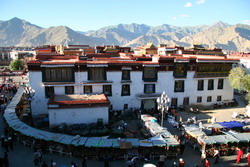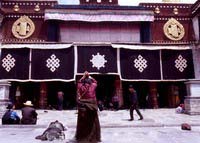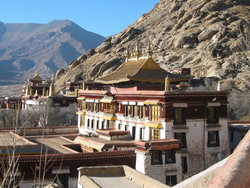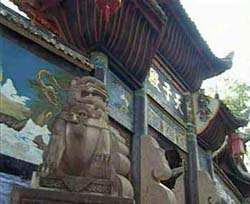| Day 6 Xian, Lhasa ( B ) |
| Transfer to airport for your flight to Lhasa. Upon arrival at the Lhasa airport, pickup by our local English speaking tour guide in Tibet and drive to hotel. Free at leisure to acclimatize yourself to the high latitude. The most important thing for the first day in Lhasa is rest! Do not be too active today.
|
| Lhasa | Lhasa has an elevation of 3650 meters and sits at the center of the Tibet Plateau. It has a history of more than 1300 years. It towers as a huge magnet attracting those who want to explore its culture. Entry into Lhasa allows each traveler the chance to glimpse into Tibet. |
|
 |
| [ Optional ] Ramoche Monastery: it is one of the key cultural relic protection sites in Lhasa, located on the north of Barkhor Street, in the area with a local market and many traditional style Tibetan style civilian houses. |
|
| Day 7 Lhasa ( B,L ) |
| Visit the famous Potala Palace and Jokhang Monastery. |
| The Barkhor Street | The Barkhor Street is Lhasa's inner pilgrim circuit shaped roughly like an octagon that runs around the Jokhang. The circuit is lined with markets, shops, stalls and street vendors providing every conceivable item a Tibetan could need. The best place to start the circuit is right outside the Jokhan…… | | The Jokhang Temple | The Jokhang Temple is the spiritual centre of Tibet - a destination for millions of Tibetan pilgrims. The oldest part of the temple dates back to the 7th century AD - being one of the two temples built by King Songsten Gampo to house the statues of the Buddha that his two foreign wives brought to Ti…… | | The Potala Palace | The Potala Palace is a landmark of Lhasa and Lama Buddism. It is a 13 storey and 1000 rooms' palace and once winter residence of the Dalai Lama. The construction of the present structure began during the reign of the fifth Dalai Lama in 1645 and took more than 50 years to complete. |
|
 |
| [ Optional ] Tibetan Family Visit: Every Tibetan family has been either directly or indirectly affected by the Chinese, Indian and Nepal culture. Family life is one of the most interesting attractions during your stay in Tibet. Common Tibetan people welcome you to their homes, greet you in their traditional way and entertain you with their typical food. |
|
| Day 8 Lhasa ( B,L ) |
| Continue to visit more famous attractions in Lhasa. |
| The Tibet Museum | The Tibet Museum, located in the southeastern corner of Norbu Lingka, Lhasa, is the first of its kind in Tibet to be provided with the latest in equipment and facilities. The Tibet Museum was completed and opened in October 1999. | | Norbulingka | The Norbulingka Park: Norbulingka means "Jeweled Garden". It was constructed as a summer palace for the Dalai Lama at the very beginning and later served as the whole governmental administration. | | The Sera Monastery | The Sera Monastery lies on the northern edge of Lhasa at the base of Tatipu Hill. 'Sera' means 'merciful hail' denoting its rivalry with the 'Rice Heap' (Drepong) since hail destroys rice. Sera was smaller than Drepong with about 7,000 monks but was very rich and comparable in power. |
|
 |
| [ Optional ] Lhasa Carpet Factory: Lhasa Carpet Factory is a factory south of Yanhe Dong Lu near the University of Tibet in Lhasa the capital of Tibet. It produces traditional Tibetan rugs. The highland of Tibet is the actual home of the oriental carpets. By visiting Carpet Factory you will have a general idea of how carpets are produced. |
|
| Day 9 Lhasa, Chongqing ( B,L ) |
| Transfer to airport for your flight to Chongqing.Pickup from Chongqing airport and begin local tours in Chongqing. We'll board on the ship for Yangtze cruise in the evening.
|
| Baoding Mountain Chongqing | Baoding Mountain (baoding shan), is renowned for the examples of stone carving that exist in the grottoes here. This is a Buddhist Mountain and held in high regard by local practicing monks in the area. | | Dazu Grottoes | In Dazu County, some 165 kilometers away from Chongqing, are more than 40 sites of stone carvings with over 50,000 statues of Buddha completed from the late Tang Dynasty (618-907) to the Song Dynasty (960-1279). |
|
 |
| [ Optional ] Ciqikou Ancient Town: Ciqikou Old Town was once the home of many of Chongqing's rich merchants, where you can still see lots of Ming and Qing dynasty architecture, local shops, tea houses, local Sichuan street performance and so on.. |
|
| Day 10 Yangtze Cruise ( B,L,D ) |
| Arrive Fengdu in the morning. Shore excursion to Fengdu Ghost City (08h00-10h00). |
| Fengdu Ghost City | Fengdu is where the devil lives, according to Chinese legend. They say that spirits go to heaven, and evil goes to Fengdu. The town is overlooked by Ming Shan Hill, home of Tianzi, the King of the Dead. The whole place has an eerie feel to it with deserted streets, tower blocks, empty shops and bank…… |
|
 |
| [ Optional ] Qutang Gorge: With vertical cliffs of some thousand meters high as its two flanks, the Qutang Gorge is only a few dozens of meters wide just like a narrow gateway. The surging Yangtze River pours into the gateway with great momentum. Looking up towards the tops of towering precipitous mountains along the Gorge, one sees from a boat only a narrow strip of clouds and sky, but under foot the River tears on violently. |
|